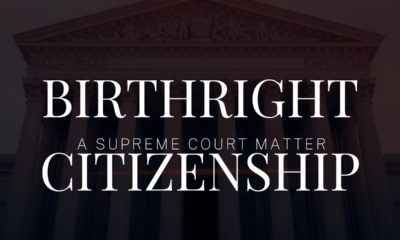Constitution
Mifepristone in court
A Texas judge is hearing a legal challenge to the approval of mifepristone, a popular abortifacient, on patient safety grounds.
Late last year, the federal Office of Legal Counsel published an opinion that sending mifepristone and misoprolol through the mail did not violate the Comstock Act against sending abortion drugs through the mail. But now mifepristone itself is in court – or rather, the FDA is in court, defending its approval of it. Last week a federal judge “stayed” the approval of the drug, while he hears a lawsuit challenging that approval. This case will very likely land in the Supreme Court, because already another judge in another circuit has ruled to the essentially opposite effect (though in seventeen States only). More to the point, this judge has already frostily disapproved of that OLC Memo.
What is mifepristone?
Mifepristone is today the most popular chemical abortifacient. The drug firm Roussel-UCLAF developed it in 1980 and brought it to market in France in 1987. It became available in the United States in 2000. Typically one takes it as a pill during the first 63 days of pregnancy. One then takes misoprostol, a prostaglandin analog, to expel the remains of the unborn child.
The problem for regulators – and what Biden’s Office of Legal Counsel relied upon – is that mifepristone has other uses. In low doses, one can use it for emergency contraception – though the preferred drug for that is levonorgestrel (“Plan B”). More to the point, doctors have used the mifepristone-misoprostol combination to treat women following miscarriage. Doctors have also prescribed it for leiomyoma (“fibroids”) and endometriosis.
These other uses prompted the OLC to state, in its December 23 opinion, that:
We conclude that section 1461 does not prohibit the mailing, or the delivery or receipt by mail, of mifepristone or misoprostol where the sender lacks the intent that the recipient of the drugs will use them unlawfully.
And because one might use the drug for these other purposes, the Postal Service has no way to know. So says the OLC.
Ed Whelan, the Antonin Scalia Chairman for Constitutional Studies at the Ethics and Policy Center, challenged that opinion. But pro-life advocates did not wait to file a citizen’s complaint under the Comstock Act. Instead they challenged the FDA itself to defend its approval of the drug.
Enter the ADF
Alliance Defending Freedom has a case in the U.S. District Court for the Northern District of Texas (Amarillo Division). The case of Alliance for Hippocratic Medicine et al. v. FDA et al. charges that the FDA violated its own processes in approving mifepristone. ADF, in their article on the case, say:
By illegally approving chemical abortion drugs, the U.S. Food and Drug Administration failed to abide by its legal obligations to protect the health, safety, and welfare of girls and women. The FDA never studied the safety of the drugs under the labeled conditions of use, ignored the potential impacts of the hormone-blocking regimen on the developing bodies of adolescent girls, disregarded the substantial evidence that chemical abortion drugs cause more complications than surgical abortions, and eliminated necessary safeguards for pregnant girls and women who undergo this dangerous drug regimen.
They presented their argument on March 15, and asked Judge Matthew J. Kacsmaryk to enjoin the FDA from listing mifepristone and misoprolol, in that combination, as approved drugs. On Friday, April 7, Judge Matthew J. Kacsmaryk “stayed” that approval. A stay in this context is less than an injunction but more than simply vacating the approval., If the court vacated the approval, the FDA could simply start again. This puts everything on hold – unless, in the week to come, the Fifth Circuit Court of Appeals says otherwise.
Judge Kacsmaryk’s opinion
Judge Kacsmaryk’s opinion reflects great anger with the FDA, and impatience with the OLC. In fact, the plaintiffs have been challenging the FDA since 2002, two years after the 2000 approval. In an obvious bid to dismiss a “you waited too long” argument, the court bluntly said:
Simply put, FDA stonewalled judicial review — until now.
To be specific:
Before Plaintiffs filed this case, FDA ignored their petitions for over sixteen years, even though the law requires an agency response within “180 days of receipt of the petition.” 21 C.F.R. § 10.30(e)(2)). But FDA waited 4,971 days to adjudicate Plaintiffs’ first petition and 994 days to adjudicate the second. See ECF Nos. 1-14, 1-28, 1-36, 1-44 (“2002 Petition,” “2019 Petition,” respectively). Had FDA responded to Plaintiffs’ petitions within the 360 total days allotted, this case would have been in federal court decades earlier. Instead, FDA postponed and procrastinated for nearly 6,000 days. Emphasis in original
After that, the judge describes what mifepristone does, and then describes the approval process. Tellingly, at first the FDA showed reluctance. But months later – before the Election of 2000 – the FDA approved the drug under “Subpart H.” That subpart exists for drugs to treat “serious or life-threatening illnesses.” In other words, the FDA regarded pregnancy as an illness – and a serious or life-threatening one at that!
Two endearing features
Note that the judge explicitly dropped the word fetus, and wrote instead of the “unborn human” or “unborn child” instead. In a footnote:
Jurists often use the word “fetus” to inaccurately identify unborn humans in unscientific ways. The word “fetus” refers to a specific gestational stage of development, as opposed to the zygote, blastocyst, or embryo stages. See Robert P. George & Christopher Tollefsen, Embryo 27–56 (2008) (explaining the gestational stages of an unborn human). Because other jurists use the terms “unborn human” or “unborn child” interchangeably, and because both terms are inclusive of the multiple gestational stages relevant to the FDA Approval, 2016 Changes, and 2021 Changes, this Court uses “unborn human” or “unborn child” terminology throughout this Order, as appropriate.
Then the judge named the Population Council as applying to get FDA approval for mifepristone. And he explained who they are.
The Population Council was founded by John D. Rockefeller in 1952 after he convened a conference with “population activists” such as Planned Parenthood’s director and several well-known eugenicists. Matthew Connelly, Fatal Misconception: The Struggle to Control World Population 156 (2008). The conference attendees discussed “the problem of ‘quality.’” John D. Rockefeller, On the Origins of the Population Council, 3 Population and Dev. Rev. 493, 496 (1977). They concluded that “[m]odern civilization had reduced the operation of natural selection by saving more ‘weak’ lives and enabling them to reproduce,” thereby resulting in “a downward trend in . . . genetic quality.” Id.
The dreadful record of mifepristone
Judge Kacsmaryk then details the record of mifepristone under its Subpart H approval:
deaths of at least 8 women, 9 life-threatening incidents, 232 hospitalizations, 116 blood transfusions, and 88 cases of infection.
But the FDA stalled on the 2002 petition for fourteen years, finally rejecting it in 2016 (during the Obama administration). And:
That same day, FDA approved several changes to the chemical abortion drug regimen, including the removal of post-approval safety restrictions for pregnant women and girls. FDA increased the maximum gestational age from seven-weeks gestation to ten-weeks gestation. And FDA also: (1) changed the dosage for chemical abortion; (2) reduced the number of required in-person office visits from three to one; (3) allowed non-doctors to prescribe and administer chemical abortions; and (4) eliminated the requirement for prescribers to report non-fatal adverse events from chemical abortion.
Remember that last; it becomes important for judging a later FDA determination. Two of the plaintiffs petitioned again in 2019. A month later the FDA approved a generic form of mifepristone – and cut more corners in that approval process. And on April 12, 2021, the FDA allowed dispensation of mifepristone and misoprolol through the mail, citing the SARS-CoV-2 pandemic. This act violates the Comstock Act, which forbids sending such drugs through the mail. Finally, in December 2021, the FDA rejected the second petition.
Granting the stay – the whys and wherefores
The judge uses more than fifty-five pages to justify the stay. For much of this memo, he addresses concepts like standing, likelihood of prevailing on merits, irreparable harm, and public interest. But in reaching his decision, Judge Kacsmaryk reveals even more chilling information. He speaks of such harms as:
- Adverse events overwhelming the medical system by creating medical emergencies and complications,
- Having to complete an “incomplete” pregnancy termination to save a life this drug has placed in danger,
- Preventing the practice of evidence-based medicine and interfering with informed consent, and
- As many as fourteen percent of women not hearing about the side effects.
The plaintiffs themselves raised the issue of Comstock Act violations. In addressing these, the court made a devastating observation: Biden’s Office of Legal Counsel ruined their case with their ill-considered memo. The very act of writing that memo demonstrating that the pursuit of purely administrative remedies would be futile. Courts, in requiring exhaustion of remedies, do not require parties to make futile gestures. Furthermore, Judge Kacsmaryk tore apart that memo exactly as Ed Whelan did three months ago. (The court didn’t cite Whelan’s three-part series, nor apparently did Whelan file any briefs.) He did this to show that the plaintiffs are very likely to prevail on the merits – because mailing these drugs does violate the Comstock Act. In fact the law is as plain as one could write it – so said the judge.
The Administrative Procedures Act
Recall the Court’s observation that the FDA “eliminated the requirement for prescribers to report non-fatal adverse events from chemical abortion.” The Court then observed that in 2021, the FDA relied on Adverse Event Reporting System data. How could those data be complete if adverse events were not reportable? Thus the Court found the FDA’s actions “arbitrary and capricious.” That puts the FDA in violation of the Administrative Procedures Act.
[I]t is circular and self-serving to practically eliminate an “adverse event” reporting requirement and then point to a low number of “adverse events” as a justification for removing even more restrictions than were already omitted in 2000 and 2016. In other words, it is a predetermined conclusion in search of non-data — a database designed to produce a null set. But even if FDA’s explanation were well-reasoned, the actions would still run afoul of the Comstock Act and therefore violate the APA.
In addressing the FDA’s actions to protect mifepristone before 2021, the Court makes this bold statement: “Pregnancy is not an ‘illness.’” Therefore Subpart H cannot apply. The Court also denied that mifepristone and misoprostol provide a “meaningful therapeutic benefit.” To the contrary, all too many women who use those drugs feel worse, not better, afterward.
Mifepristone – unsafe at any dosage?
In two paragraphs, Judge Kacsmaryk gives a devastating critique of the 2000 approval process:
The Court does not second-guess FDA’s decision-making lightly. But here, FDA acquiesced on its legitimate safety concerns — in violation of its statutory duty — based on plainly unsound reasoning and studies that did not support its conclusions. There is also evidence indicating FDA faced significant political pressure to forego its proposed safety precautions to better advance the political objective of increased “access” to chemical abortion — which was the “whole idea of mifepristone.” As President Clinton’s Secretary for Health & Human Services (“HHS”) explained to the White House, it was FDA that arranged the meeting between the French pharmaceutical firm [Roussel-UCLAF] — who owned the mifepristone patent rights — and the eventual drug sponsor Population Council. The purpose of the FDA-organized meeting was “to facilitate an agreement between those parties to work together to test [mifepristone] and file a new drug application.”
HHS also “initiated” another meeting “to assess how the United States Government” — i.e., the Clinton Administration — “might facilitate successful completion of the negotiations” between the French firm and the American drug sponsor to secure patent rights and eventual FDA approval. Id. at 16. In fact, for their “negotiations [to be] successfully concluded,” the HHS Secretary believed American pressure on the French firm was necessary.
An inexcusable death toll
Whether FDA abandoned its proposed restrictions because of political pressure or not, one thing is clear. The lack of restrictions resulted in many deaths and many more severe or life-threatening adverse reactions. Due to FDA’s lax reporting requirements, the exact number is not ascertainable. But it is likely far higher than its data indicate for reasons previously mentioned. Whatever the numbers are, they likely would be considerably lower had FDA not acquiesced to the pressure to increase access to chemical abortion at the expense of women’s safety. FDA’s failure to insist on the inclusion of its proposed safety restrictions was not “the product of reasoned decisionmaking.” To hold otherwise would be “tantamount to abdicating the judiciary’s responsibility under the [APA] to set aside agency actions that are ‘arbitrary, capricious, an abuse of discretion, or otherwise not in accordance with law.’”
The judge went on to castigate the 2016 Changes and the 2019 Generic Approval on similar grounds. Given what the judge had already said, finding “substantial likelihood of irreparable harm” became a no-brainer. The judge also found that stopping the approval somehow would be in the public interest. Not only did the administration and the FDA fail to “take care that the laws be faithfully executed.” They also advanced eugenics arguments. Bad move!
Though eugenics were once fashionable in the Commanding Heights and High Court, they hold less purchase after the conflict, carnage, and casualties of the last century revealed the bloody consequences of Social Darwinism practiced by would-be Übermenschen.
A final analysis
Your editor is not a lawyer, but he is a doctor, and was once a clinical laboratory administrator. When Roussel-UCLAF Lot 486 first broke into American medical literature, your editor was in post-graduate training. So your editor knows all about the history of mifepristone, its original trade name (“Mifeprex”), and its sponsorship by the Population Council.
That sponsorship should tell you all you need to know about the purpose that drug serves. CNAV has said before that population is a theater of war. The Population Council wanted to lower the birth rate in America, and they have. Offering to improve “genetic quality” becomes an excuse to trend population downward. Judge Kacsmaryk dropped a hint of that in his memorandum.
Sadly, Judge Thomas Rice of the U.S. District Court for the Eastern District of Washington State, Spokane Division, has ruled opposite to Judge Kacsmaryk. He has ordered that mifepristone remain available to seventeen States that have sued to keep it available. This represents a split, not only between District Courts but also Judicial Circuits. So expect both these cases to land before the U.S. Supreme Court, possibly as soon as the 2023 Term.
When they do, the interests of unborn humans will have their strongest advocacy yet. Furthermore, the interests of the elites will clash directly with those of civilizational America.
Terry A. Hurlbut has been a student of politics, philosophy, and science for more than 35 years. He is a graduate of Yale College and has served as a physician-level laboratory administrator in a 250-bed community hospital. He also is a serious student of the Bible, is conversant in its two primary original languages, and has followed the creation-science movement closely since 1993.
-

 Civilization5 days ago
Civilization5 days agoOn the 2025 National Security Strategy
-

 Civilization3 days ago
Civilization3 days agoIvory Tower Thinking and Narcotics Boats
-

 Executive2 days ago
Executive2 days agoThe Last Supper: New York’s Socialist Feast
-

 Civilization2 days ago
Civilization2 days agoYoo Hoo, VP Vance—Your Character is Showing!
-

 Executive4 days ago
Executive4 days agoWaste of the Day: Shockingly, Inmate Phone Calls Lead to More Criminal Activity
-

 Civilization5 days ago
Civilization5 days agoIf Not a Musk, Then the Navy Needs Another Rickover
-

 Executive4 days ago
Executive4 days agoWH Ignores Demands From Pro Life Lobby To Fire FDA Commissioner
-

 Civilization2 days ago
Civilization2 days agoFacing Facts & Rolling Back Mythologies: The New National Security Strategy












